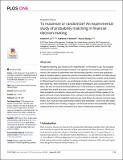To maximize or randomize? An experimental study of probability matching in financial decision making
Author(s)
Lo, Andrew W; Marlowe, Katherine P; Zhang, Ruixun
DownloadPublished version (1.270Mb)
Publisher with Creative Commons License
Publisher with Creative Commons License
Creative Commons Attribution
Terms of use
Metadata
Show full item recordAbstract
<jats:p>Probability matching, also known as the “matching law” or Herrnstein’s Law, has long puzzled economists and psychologists because of its apparent inconsistency with basic self-interest. We conduct an experiment with real monetary payoffs in which each participant plays a computer game to guess the outcome of a binary lottery. In addition to finding strong evidence for probability matching, we document different tendencies towards randomization in different payoff environments—as predicted by models of the evolutionary origin of probability matching—after controlling for a wide range of demographic and socioeconomic variables. We also find several individual differences in the tendency to maximize or randomize, correlated with wealth and other socioeconomic factors. In particular, subjects who have taken probability and statistics classes and those who self-reported finding a pattern in the game are found to have randomized more, contrary to the common wisdom that those with better understanding of probabilistic reasoning are more likely to be rational economic maximizers. Our results provide experimental evidence that individuals—even those with experience in probability and investing—engage in randomized behavior and probability matching, underscoring the role of the environment as a driver of behavioral anomalies.</jats:p>
Date issued
2021Department
Sloan School of Management; Sloan School of Management. Laboratory for Financial Engineering; Massachusetts Institute of Technology. Computer Science and Artificial Intelligence LaboratoryJournal
PLOS ONE
Publisher
Public Library of Science (PLoS)